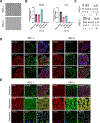Generation and characterization of two iPSC lines derived from subjects with Free Sialic Acid Storage Disorder (FSASD)
- PMID: 39461116
- PMCID: PMC12208114
- DOI: 10.1016/j.scr.2024.103600
Generation and characterization of two iPSC lines derived from subjects with Free Sialic Acid Storage Disorder (FSASD)
Abstract
Free sialic acid storage disorder (FSASD) is a rare, autosomal recessive, neurodegenerative disorder caused by biallelic mutations in SLC17A5, encoding the lysosomal transmembrane sialic acid exporter, SLC17A5. Defects in SLC17A5 lead to lysosomal accumulation of free sialic acid and other acid hexoses. The clinical spectrum of FSASD ranges from mild (Salla disease) to severe infantile forms. The pathobiology underlying FSASD remains elusive. In this study, two induced pluripotent stem cell (iPSC) lines were generated from a mild and an intermediate FSASD patient and characterized to provide much-needed additional models for basic and translational studies.
Published by Elsevier B.V.
Conflict of interest statement
Declaration of competing interest The authors declare that they have no known competing financial interests or personal relationships that could have appeared to influence the work reported in this paper.
Figures
References
-
- Adams D, Wasserstein M Free Sialic Acid Storage Disorders. 2003 Jun 13 [Updated 2020 Jan 23]. In: Adam MP, Ardinger HH, Pagon RA, et al. , eds. GeneReviews. University of Washington, Seattle; 2003. In: Adam MP, Ardinger HH, Pagon RA, et al., editors. GeneReviews® [Internet]. Seattle (WA): University of Washington, Seattle; 1993–2022. Available from: https://www.ncbi.nlm.nih.gov/books/NBK1470/. - PubMed
Publication types
MeSH terms
Substances
Grants and funding
LinkOut - more resources
Full Text Sources


